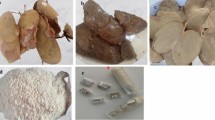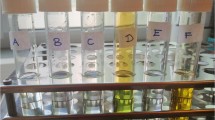Abstract
During y-irradiation (5 kGy) of aqueous tryptophan (Trp) solutions small amounts of 5-, 6-, and 7-hydroxytryptophan (OH-Trp) (0.04-0.08 Mol-%) are formed. Protein rich food like shrimps contain reasonable amounts of non-protein bound Trp (100 mg/kg). In order to detect the treatment of shrimps with y-irradiation a method for the determination of OH-Trp in y-irradiated shrimps was developed. After homogenization, squeezing of shrimp samples and protein precipitation, a two-step-SPE-clean up was performed using a C18-cartridge and a propylsulfonic acid cation-exchange SPE followed by HPLC analysis with electrochemical detection (750 mV). Results showed that 5-OH-Trp contents in shrimp samples increased with applied doses up to 3 kGy and then decreased with higher doses. Other OH-Tip isomers were not detectable in the irradiated shrimps. Similarly no formation of 4-, 6-, and 7-OH-Tip was detected in model solutions containing the same amino acid composition as in shrimps. This indicates a suppression of the reaction of OH-radicals with Trp by the 300 fold molar excess of other amino acids acting as well as radical scavengers. Therefore, non-physiological OH-Tip isomers formed from free Tip are not suitable as markers for the detection of y-irradiated protein-rich foodstuff.
Access this chapter
Tax calculation will be finalised at checkout
Purchases are for personal use only
Preview
Unable to display preview. Download preview PDF.
Similar content being viewed by others
References
I. WHO, High-Dose Irradiation: Wholesomeness of Food Irradiated with Doses above 10 kGy. Report on a Joint FAO/IAEA/WHO Expert CommitteeWHO Techn. Rep. Ser. 890,World Health Organization, Geneva, 1999.
D.A.E. Ehlermann, H Delincée, Die Strahlenkonservierung von Lebensmitteln, Zentralstelle air Agrardokumentation und -information (ZADI), Bundesministerium für Ernährung, Landwirtschaft und Forsten (BML): http://www.dainet.de/bfe/deutsch/eh106.htmoctober 9th, 1998.
P. Loaharanu, Irradiation as a cold pasteurization process of foodVet. Parasitoi. 64, 71–82 (1996).
Food and Environmental Protection Newsletter. Supplement, volume I, No. 2, June. 1998.
Directive 1999/2/EC on the approximation of the laws of the Member States concerning foods and food ingredients treated with ionising radiation, OJ L 66, 16–23, mars 13th1999.
Directive 1999/3/EC on the establishment of a Community list of foods and food ingredients treated with ionising radiation, 0.1 L 66, 24–25, mars 13th1999.
Communication from the Commission on foods and food ingredients authoriscd for treatment with ionising radiation in the Community, OJ C 241, 6–1 1, 2001.
B. Van Wickern, B. Müller, T.J. Simat, H. Steinhart, Determination of y-radiation products in aqueous solutions of tryptophan and synthesis of 4-, 6- and 7-hydroxytryptophan, J. Chromatogr.786,57–65 (1997).
B. Van Wickern, T.J. Simat, H. Steinhart, HPLC analysis of y-irradiation-induced products of tryptophan in peptides and lysozymeZ. Lebensm. Unters. Forsch. 205,446–451 (1997).
K.K. Kleeberg, B. van Wickern, T.J. Simat, H. Steinhart, Determination of hydroxytryptophan isomers in y-irradiated egg white, chicken meat, and shrimpsAdv. Exp. Med. Biol. 467, 685–691 (1999).
R.E. Weber, W.J.A. van Marrewijk, Free amino acids in the shrimpCrangon crangonand their osmoregulatory significance,Neth. J. Sea Res., 5, 391–415 (1972).
G.L. Fletcher, S. Okada, Radiation-induced formation of dihydroxy-phenylalanine from tyrosine and tyrosine-containing peptides in aqueous solutionRadiai. Res. 15, 349–354 (1961).
Author information
Authors and Affiliations
Editor information
Editors and Affiliations
Rights and permissions
Copyright information
© 2003 Springer Science+Business Media New York
About this chapter
Cite this chapter
Kleeberg, K.K., Müller, A., Simat, T.J., Steinhart, H. (2003). Suitability of Tryptophan Radiation Products as Markers for the Detection of γ-Irradiated Protein Rich Food. In: Allegri, G., Costa, C.V.L., Ragazzi, E., Steinhart, H., Varesio, L. (eds) Developments in Tryptophan and Serotonin Metabolism. Advances in Experimental Medicine and Biology, vol 527. Springer, Boston, MA. https://doi.org/10.1007/978-1-4615-0135-0_80
Download citation
DOI: https://doi.org/10.1007/978-1-4615-0135-0_80
Publisher Name: Springer, Boston, MA
Print ISBN: 978-1-4613-4939-6
Online ISBN: 978-1-4615-0135-0
eBook Packages: Springer Book Archive




